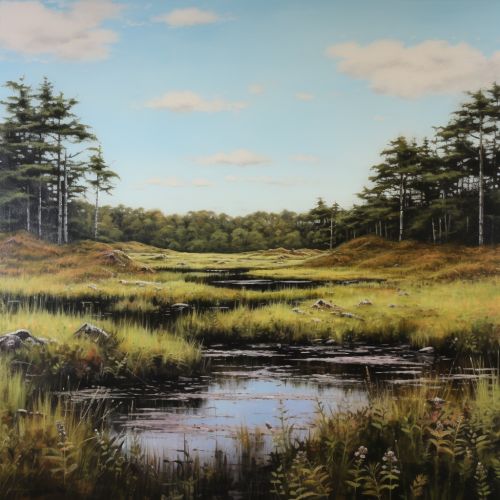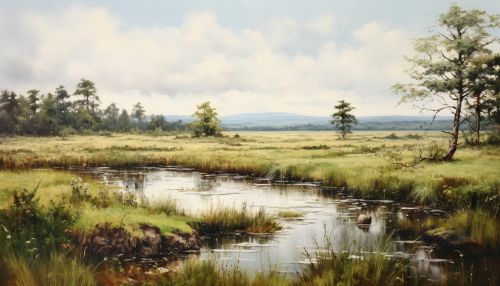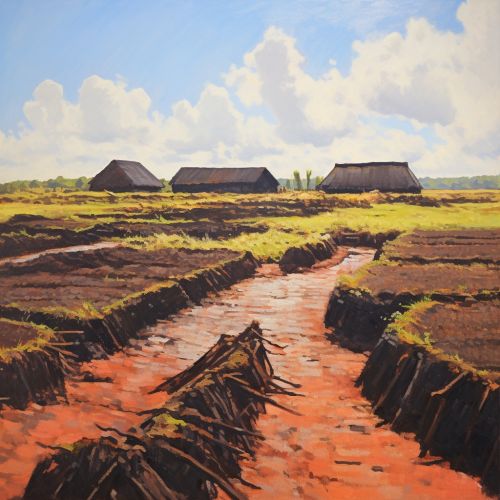Peat
Overview
Peat is a type of soil-like material that is rich in organic matter. It is formed from the partial decomposition of plant material in wet, acidic conditions, such as those found in bogs and fens. The process of peat formation, known as peatification, is slow and can take thousands of years. Peat is notable for its high carbon content and its ability to store large amounts of water, making it an important component of many wetland ecosystems.


Formation and Characteristics
Peat forms in wetland conditions where the rate of plant growth exceeds the rate of decomposition. This imbalance is due to the waterlogged, acidic, and often low-oxygen conditions that inhibit the activity of decomposer organisms. Over time, layers of partially decomposed plant material accumulate to form peat. The type of vegetation present in the wetland can influence the characteristics of the peat. For example, peat formed from sphagnum moss, known as sphagnum peat, is particularly absorbent and acidic.
Peat is characterized by its high organic matter content, typically comprising over 90% of its dry weight. It is also notable for its high water-holding capacity, which can be up to 20 times its dry weight. This makes peat an important component of wetland hydrology, helping to regulate water flow and maintain high water tables.
Types of Peatlands
Peatlands are the ecosystems where peat is formed and accumulated. They cover approximately 3% of the Earth's land surface and are found in many parts of the world, including northern Europe, North America, Southeast Asia, and parts of the Southern Hemisphere. There are several types of peatlands, including bogs, fens, and swamps, each with their own specific characteristics and vegetation types.
Bogs are peatlands that receive water primarily from precipitation. They are typically acidic and nutrient-poor, with vegetation dominated by sphagnum mosses, sedges, and low-growing shrubs.
Fens are peatlands that receive water from groundwater or surface water sources, in addition to precipitation. They are typically less acidic than bogs and have a greater diversity of plant species, including reeds, grasses, and various types of mosses.
Swamps are forested peatlands that are flooded either permanently or seasonally. They can be rich in nutrients and support a wide variety of plant and animal species.
Uses of Peat
Peat has been used by humans for thousands of years for a variety of purposes. One of the most well-known uses of peat is as a fuel source. Peat has a high carbon content and can be burned to produce heat and electricity. In some countries, such as Ireland and Finland, peat is still used as a significant source of energy.
Peat is also widely used in horticulture, particularly as a soil amendment. Its high water-holding capacity and acidity make it ideal for growing certain types of plants, such as orchids and blueberries. However, the use of peat in horticulture has been criticized due to the environmental impacts of peat extraction.
In addition to these uses, peat has been used in various other ways throughout history, including for insulation, for the production of alcoholic beverages, and even for preserving bodies, as in the case of the famous bog bodies of northern Europe.


Environmental Importance and Concerns
Peatlands play a crucial role in the global carbon cycle. They are among the world's most important carbon sinks, storing more carbon than all the world's forests combined. This is due to the slow rate of decomposition in peatlands, which allows carbon to be stored in the peat for thousands of years. However, when peatlands are drained or disturbed, this carbon can be released back into the atmosphere as carbon dioxide, a potent greenhouse gas.
In addition to their role in carbon storage, peatlands also provide important habitat for a wide variety of plant and animal species, many of which are specially adapted to the unique conditions of peatlands. They also play a key role in water regulation, helping to prevent flooding and maintain water quality by filtering out pollutants.
Despite their environmental importance, peatlands are under threat from a variety of human activities. Peat extraction for horticulture and fuel is a major cause of peatland degradation, as is drainage for agriculture and forestry. These activities not only destroy peatland habitats but also contribute to climate change by releasing stored carbon into the atmosphere.
Efforts are being made to conserve and restore peatlands around the world. These include the establishment of protected areas, the promotion of sustainable peatland management practices, and the restoration of degraded peatlands through activities such as rewetting and revegetation.
